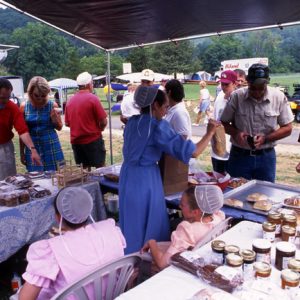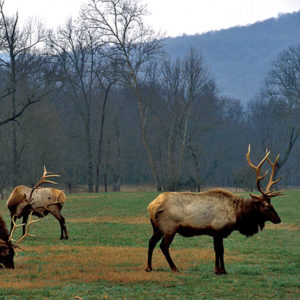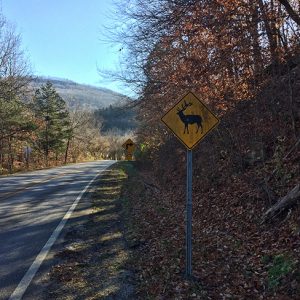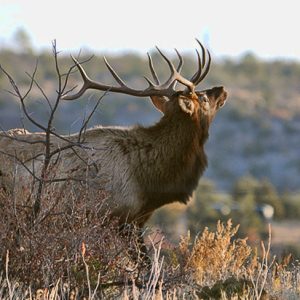calsfoundation@cals.org
Elk
Among the many success stories involving wildlife in Arkansas, a high-profile example is the elk of the Buffalo National River country. Wiped out in pioneer and early settlement days, the elk were brought back beginning in 1981, and, since then, the big animals have become well enough established that they can be hunted on a limited basis. The elk have also become a reliable tourist attraction in Newton County and the surrounding area.
Elk were native to Arkansas but were wiped out by changing habitat, mostly the clearing of land. The variety in the area in the early days was the eastern subspecies of elk, which is extinct. By the time Arkansas became a state in 1836, elk were dwindling, and they were gone entirely by the 1840s. The name “elk” persisted in several locations, however. Elkhorn Tavern was used in the Battle of Pea Ridge in northwest Arkansas in the Civil War. Elkhorn Bank is a venerable institution in Arkadelphia (Clark County).
Two attempts at bringing elk back to Arkansas were made in the early and mid-twentieth century. One was a commercial venture near Eureka Springs (Carroll County). The second was conducted by the U.S. Forest Service in the Ozark National Forest north of Ozark (Franklin County). Neither succeeded.
In 1979, Governor Bill Clinton named Hilary Jones to the Arkansas Game and Fish Commission (AGFC), Clinton’s first AGFC appointment. Jones lived at Pruitt (Newton County), close to the Buffalo River. He and a handful of friends, fellow elk hunters and appreciators, thought the public lands of the Buffalo River would make suitable habitat for elk and began work on reintroducing them in 1981. After an agreement was made for a swap with the state of Colorado—elk in exchange for Arkansas channel catfish—Jones and friends, cattle raisers, and truckers convoyed stock trailer rigs to Colorado and brought the first elk back to the Buffalo River. These were a Rocky Mountain subspecies of elk. More convoys followed, with a few surplus elk from Nebraska’s Sand Hills country joining those from Colorado.
The elk did well, and concerns faded about the ability of the high country elk of the Rocky Mountain variety to adapt to hot and humid Arkansas. In 1982, the first elk calf was born in Arkansas, and the herd has slowly grown to an estimated 450 to 500 animals as of 2009.
The restoration that began in 1981 was an AGFC project, but the agency soon included the National Park Service, the Rocky Mountain Elk Foundation, and local landowners. They partnered on extensive habitat work, a prime factor in the program’s success. Equally significant has been the protective attitude of residents in the Buffalo River country toward the elk, as the herd became a new Arkansas tourist attraction. The AGFC operates two facilities in Newton County connected to the elk—the Ponca Elk Education Center and the Hilary Jones Wildlife Museum at Jasper. The Buffalo River Elk Festival is an annual late June event around Jasper’s courthouse square.
Limited hunting of Arkansas elk began in 1998 with twenty permits issued. The number of permits was increased to twenty-six in 2008, with three of them designated for hunters fifteen and younger. Several thousand Arkansas hunters apply for the free permits each year.
For additional information:
Bowden, Bill. “In Fall, Shy Elk Move into Open.” Arkansas Democrat-Gazette, September 23, 2018, pp. 1A. 7A.
Jenkins, Cary. “Eyeing the Elk.” Arkansas Democrat-Gazette, October 25, 2020, pp. 1E, 3E.
Mosby, Joe, Jeff Williams, and Randy Zellers. “Early Elk Along the Buffalo: September Hunt Yields Impressive Bulls.” Arkansas Wildlife 35 (November–December 2004): 17–18.
Telesco, Rebecca L., Frank T. Van Manen, Joseph D. Clark, and Michael E. Cartwright. “Identifying Sites for Elk Restoration in Arkansas.” Journal of Wildlife Management 71 (July 2007): 1393–1403.
Joe Mosby
Conway, Arkansas
 Endangered, Threatened, and Rare Species
Endangered, Threatened, and Rare Species Environment
Environment Mammals
Mammals Buffalo River Elk Festival
Buffalo River Elk Festival  Elk at Ponca
Elk at Ponca  Elk Crossing
Elk Crossing  Elk Bull
Elk Bull 




Comments
No comments on this entry yet.